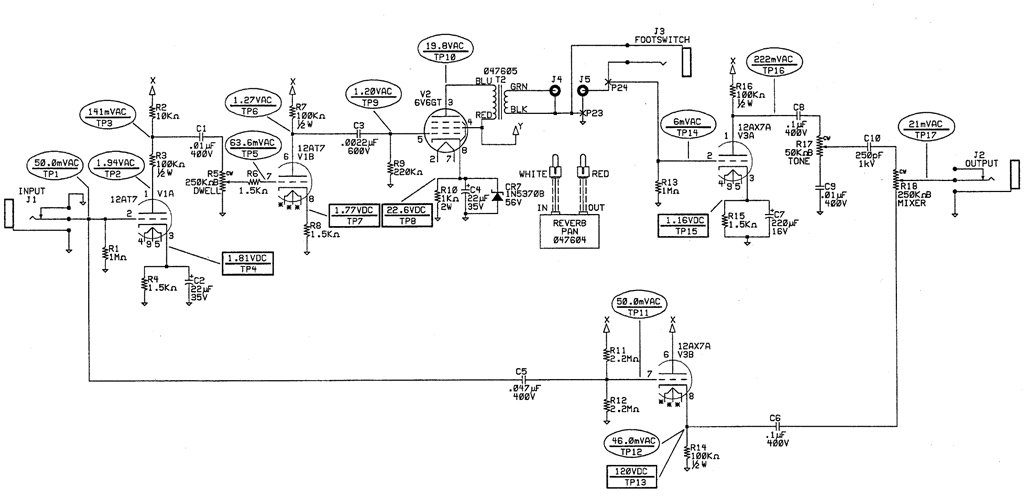Originally posted by 66 Kicks
View Post
How much the tank shakes the springs depends on how much AC current is flowing through the input coil. We would prefer that the springs shake the same at all of the frequencies that concern us, so we want constant current for those frequencies. In order to get constant current from your driver, the load presented by the coil circuit must be constant. This isn't going to happen with just a capacitor and a coil.
The impedance of a capacitor changes with frequency and so does a coil. The total impedance of a capacitor and a coil in series is the absolute value of the difference of the two impedance values at any given frequency. At low frequencies, the capacitor has a high impedance and the coil has a low impedance so that the total impedance is approximately the capacitor impedance. At high frequencies, the capacitor has a low impedance and the coil has a high impedance so that the total impedance is approximately the coil impedance.
In between the two impedance extremes the impedance drops. When the impedance of the capacitor equals the impedance of the coil, the theoretical impedance drops to zero. In practice there is still some impedance, but it is very low. This brings up the first problem with the 0.1uf capacitor. With a 4F tank, the very low impedance occurs at just over 1KHz. At and around this frequency the signal gets an ugly clip and the reverb sound is undesirable.
The second problem with a 0.1uf capacitor is that the higher impedance at lower frequencies causes less current to flow through the coil than at mid and high frequencies.
If you add a resistor between the capacitor and the coil, you have a series LRC circuit. The total impedance of this is the square root of the sum of the squared value of the resistor and the squared value of the total impedance of the capacitor in series with the coil. Obviously, if we make R very large, the total impedance is approximately R and all of the problems with a 0.1uf capacitor go away. The current will be constant, but there won't be much of it. So we hit the calculator to find an R that is much lower but that still gives us an acceptable range of total impedances at the frequencies that concern us.
After a few strokes on the calculator, the 0.1uf problem reappears. The high impedance at lower frequencies forces us to use an R that is higher than what we want. So we raise the value of the capacitor to decrease the impedance at lower frequencies. I don't want to use a huge electrolytic here because they are expensive at that voltage and they are bulky. I want the smallest one that causes the LRC equation to come out close to what I want.
So it is all a balancing act and 1.0uf, 3Kohms, and a 0.235H coil is acceptable to me.
The impedance of a capacitor changes with frequency and so does a coil. The total impedance of a capacitor and a coil in series is the absolute value of the difference of the two impedance values at any given frequency. At low frequencies, the capacitor has a high impedance and the coil has a low impedance so that the total impedance is approximately the capacitor impedance. At high frequencies, the capacitor has a low impedance and the coil has a high impedance so that the total impedance is approximately the coil impedance.
In between the two impedance extremes the impedance drops. When the impedance of the capacitor equals the impedance of the coil, the theoretical impedance drops to zero. In practice there is still some impedance, but it is very low. This brings up the first problem with the 0.1uf capacitor. With a 4F tank, the very low impedance occurs at just over 1KHz. At and around this frequency the signal gets an ugly clip and the reverb sound is undesirable.
The second problem with a 0.1uf capacitor is that the higher impedance at lower frequencies causes less current to flow through the coil than at mid and high frequencies.
If you add a resistor between the capacitor and the coil, you have a series LRC circuit. The total impedance of this is the square root of the sum of the squared value of the resistor and the squared value of the total impedance of the capacitor in series with the coil. Obviously, if we make R very large, the total impedance is approximately R and all of the problems with a 0.1uf capacitor go away. The current will be constant, but there won't be much of it. So we hit the calculator to find an R that is much lower but that still gives us an acceptable range of total impedances at the frequencies that concern us.
After a few strokes on the calculator, the 0.1uf problem reappears. The high impedance at lower frequencies forces us to use an R that is higher than what we want. So we raise the value of the capacitor to decrease the impedance at lower frequencies. I don't want to use a huge electrolytic here because they are expensive at that voltage and they are bulky. I want the smallest one that causes the LRC equation to come out close to what I want.
So it is all a balancing act and 1.0uf, 3Kohms, and a 0.235H coil is acceptable to me.
I think I'll go for the tank I presented above, 9GB2C1B. The impedance of that tank is easier to match with a ECC82 stage.



Comment